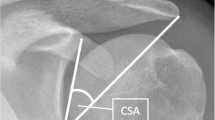Abstract
The morphologic variations of the shoulder blade have not yet been evaluated in clinical medicine. We observed that subjects with less standard shapes of the shoulder blade often suffer from musculo-skeletal shoulder syndromes with concurrent intrinsic impingement syndromes or, more precisely, partial-thickness rotator cuff tears. This experience became a basis for an experiment, in which we categorized individual phenotypes of the shoulder blade. A clinically useful finding of the presented study is a tool for predicting patients at risk for manifestations of impingement syndrome and also for prediction of easy or complicated restoration of neuromuscular stabilization of the shoulder. Lower functional potential of the external rotator muscles of the shoulder is in close relation to the individual shape of the shoulder blade, for the most part with the cranio-caudal dimension of the infraspinous fossa.





Similar content being viewed by others
References
Bigliani LU et al (1986) The morphology of the acromion and its relationship to rotator cuff tears. Orthop Trans 10:228
Davidson PA et al (1995) Rotator cuff and postseriorsuperior glenoid labrum injury associated with increased glenohumeral motion: a new site of impingement. J Shoulder Elbow Surg 4:384–390. doi:10.1016/S1058-2746(95)80023-9
Ebraheim NA et al (2000) Quantitative anatomy of the scapula. Am J Orthop 29:287–300
Edelson G et al (2000) Internal impingement in the shoulder. J Shoulder Elbow Surg 9:308–315. doi:10.1067/mse.2000.105449
Gold GE et al (2007) Abduction and external rotation in shoulder impingement: an open MR study on healthy volunteers-initial experience. Radiology 244(3):815–822. doi:10.1148/radiol.2443060998
Graves WW (1922) Observations on age changes in the scapula: a preliminary note. Am J Phys Anthropol 5:21–23. doi:10.1002/ajpa.1330050125
Gray DJ (1942) Variations in the human scapulae. Am J Phys Anthropol 29:57–72. doi:10.1002/ajpa.1330290106
Hawkins RJ et al (1998) Clinical evaluation of shoulder problems. In: ChA Rockwood, Matsen FAIII (eds) The shoulder, 2nd edn. W.B. Saunders, Philadelphia
Holibka R et al (2003) Some peculiarities of the rotator cuff muscles. Biomed Pap Med Fac Univ Palacky Olomouc Czech Repub 147(2):233–237
Hrdlicka A (1941) The adult scapula. Additional observations and measurements. Am J Phys Anthropol 29:363–415. doi:10.1002/ajpa.1330290303
Matsen FAIII et al (1998) Glenohumeral instability. In: ChA Rockwood, Matsen FAIII (eds) The shoulder, 2nd edn. W.B. Saunders, Philadelphia
Martin R, Saller K (1957) Lehrbuch der Anthrophologie. Verlag von Gustav Fischer
McComas AJ (1996) Skeletal muscle form and function. Human Kinetics, Ontario
Moore KL, Persaud TVN (1998) The developing human—clinically oriented embryology, 6th edn. W.B. Saunders, Philadelphia
Neer CS 2nd (1972) Anterior acromioplasty for the chronic impingement syndrome in the shoulder: a preliminary report. J Bone Joint Surg Am 54(1):41–50
Neer CS 2nd (1983) Impingement lesion. Clin Orthop Relat Res 173:70–77
Neer CS 2nd, Welsh RP (1977) The shoulder in sports. Orthop Clin North Am 8(3):583–591
O’Brien SJ et al (1998) Developmental anatomy of the shoulder and anatomy of the glenohumeral joint. In: ChA Rockwood, Matsen FAIII (eds) The shoulder, 2nd edn. WB Saunders Company, Philadelphia
Pappas GP et al (2006) In vivo anatomy of the Neer and Hawkins sign position for shoulder impingement. J Shoulder Elbow Surg 15(1):40–49. doi:10.1016/j.jse.2005.04.007
Penning R et al (1988) Sexual dimorphism of the scapula. Z Rechtsmed 101(3):83–96. doi:10.1007/BF00201113
Prescher A (2000) Anatomical basis, variations, and degenerative changes of the shoulder joint and shoulder girdle. Eur J Radiol 35:88–102. doi:10.1016/S0720-048X(00)00225-4
Von Schroeder HP et al (2001) Osseous anatomy of the scapula. Clin Orthop Relat Res 383:131–139. doi:10.1097/00003086-200102000-00015
Soderberg GL (1997) Kinesiology: application to pathological motion. Wiliams & Willkins, Baltimore
Walch G et al (1992) Impingement of the deep surface of the supraspinatus tendon on the posterosuperior glenoid rim: an arthroscopic study. J Shoulder Elbow Surg 1:238–245. doi:10.1016/S1058-2746(09)80065-7
Yochum TR et al (1996) Essentials of skeletal radiology, 2nd edn. Williams & Wilkins, Baltimore
Acknowledgments
This research was supported by MSMT CR VZ 6198959221.
Author information
Authors and Affiliations
Corresponding author
Additional information
ISG 2008: Shoulder biomechanics in medicine, ergonomics and sport.
Rights and permissions
About this article
Cite this article
Krobot, A., Janura, M. & Elfmark, M. Functional categorization of the individual morphology of the scapula. Med Biol Eng Comput 47, 497–506 (2009). https://doi.org/10.1007/s11517-009-0486-4
Received:
Accepted:
Published:
Issue Date:
DOI: https://doi.org/10.1007/s11517-009-0486-4




